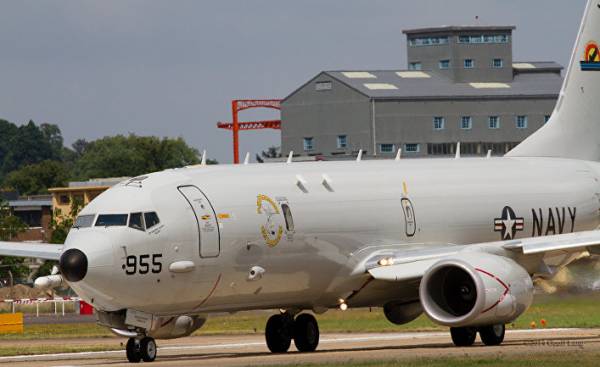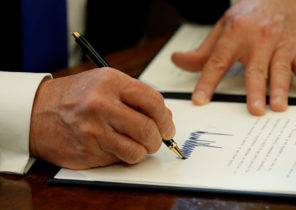
It may well be that you have already flown on Board critical of the new US Navy aircraft — or rather, aboard a 737 on the basis of which he created. Probably Maritime patrol aircraft P-8A Poseidon is not as beautiful and attractive as the fighter stealth F-35; but in a sense it is much closer to hot spots in the international waters of the Pacific ocean. Maritime patrol aircraft play a critical role in monitoring the movement of ships and especially submarines in the vast waters of the world ocean, and in the event of hostilities in their destruction.
But the hunt for submarines from the air is a very difficult job, and it requires a large number of different planes flying for many hours of great distances over the oceans. Since 1962, the US Navy is armed patrol aircraft P-3 Orion, which went four-engine airliner the L-88 Electra. This turboprop machine can last tens of hours flying at low altitude over the ocean, dropping into the water, sonar buoys, scanning the water in search of metal hulls of submarines using magnetic detector is MAD, and if necessary carrying out launches torpedoes. But R-3 has served for more than 55 years, flew thousands of hours, and their housing aged from material fatigue.
In 2004, the U.S. Navy chose to replace the outdated P-3 aircraft P-8 Poseidon Boeing. Design work progressed fairly quickly, because it used existing airframe, and it was decided to put on “Poseidon” the modern system instead of installing them all at once. For this reason, the unit cost of R-8 was even lower estimates, amounting to $ 150 million a plane.
Based on R-8 — the design of aircraft 737-800ERX short and medium range. Usually, the crew of the aircraft by three people. On the side of the machine placed powerful generators feeding the on-Board electronics. “Poseidon” in flight talks a lot less than Orion, due to the greater wingspan and navigational computers. The crew of the “Orion” often suffered from severe turbulence due to flight at low altitude, as required by the rules of the patrol.
U R-8 reinforced hull for flying at low altitude, but the fuel efficiency of the engines in these flights is lower than R-3. But mainly it affects high altitudes, where the thin atmosphere increases, fuel-efficient and gives more advantages to the detection devices. “Poseidon” can patrol at low speeds, the components of only 320 kilometers per hour, staying in the air for a long time due to the possibility of in-flight refueling. However, the top speed is 900 miles per hour, so it can fly much faster than R-3.
The basis of the payload “of Poseidon” consists of a variety of detection devices. Among them are multi-purpose search synthetic aperture radar, capable of locating aircraft at a distance of several hundred kilometers, as well as working in the high resolution mode that allows it to detect the periscopes of submarines at great distances and even recognize the ships of various types. Photoelectric/infrared MX-20 and a set of electronic support measures AN / ALQ-240, which is used aboard EA-18G Growler, operate as electromagnetic detection devices, which is especially effective at finding the location of the emitting radar.
Recently, the “Poseidon” appeared search radar, Advanced Airborne Sensor, which is a two-way active phased antenna lattice, which allows to conduct a circular search of targets on land and in coastal areas, but can also be used for interference cyber threats, and even to conduct cyber warfare.
Many important system R-8 is designed to search for submarines in submerged position. At the rear of “of Poseidon” has a rotary setting to reset in the water, sonar buoys. A recent modification of the R-8 allows the aircraft to use the new penetrating multistatic active buoys that generate multiple acoustic pulses, increasing the range and search time. R-8 is also equipped with its own acoustic sensors and even a new hydrocarbon sensors that can detect exhaust of fuel from the submarines.
However, the R-8 has no magnetic detector at the tail, like P-3 Orion, which detects the metal case of submarines during the flight of the aircraft at low altitude. It was removed for various reasons: MAD is too heavy, weighing half a ton, it is not embedded in the high-rise search profile R-8, and the new sensors on the “Poseidon” made it unnecessary. However, in the U.S. Navy are developing option launched into the air drone called High-Altitude Unmanned Targeting Air System, which can be mounted a magnetic detector, and transmitting the search data for R-8.
Five jobs of the operators on the left side is equipped with multifunction displays, which configuration allows to use necessary under certain circumstances, the sensors and control devices. Computers “Poseidon” transmit data in a single system, providing operators with a comprehensive picture of the situation. Further, these data can be sent their ships and aircraft. Such a system, the U.S. air force are trying to integrate into your aircraft AWACS E-3G. R-3 will also be compatible with UAVs, the Navy RQ-4N.
In the event of hostilities Poseidon can be equipped with five rockets, depth charges or torpedoes placed in a rotary launcher in the tail. He has six attachment points for external load. P-3 at start-up of torpedoes was to go down and fly at low altitude, and R-8 is a special device for launch from high altitude (High Altitude Air Launch Accessory), through which light 324 mm torpedo Mark 54 turn into a glide bombs with GPS, and they can be dropped from a height of nine thousand meters. Once in the water, Mark 54 resets the wings and homes in on the target by the onboard sonar. “Poseidon” can also carry on-Board anti-ship missile Harpoon AGM-184H/K with a launch range of 240 kilometers.
Some experts say that “Poseidon” can be turned into a cheap bomber b-52, equipping it with various systems of guided weapons, for example, anti-radar missiles, long-range AGM-158, LR anti-ship missiles-ASM and bombs of small caliber for precision strikes on ground targets. It is unclear whether they want the Navy to make “Poseidon” multi-purpose aircraft, or it will still be used to combat submarines and surface ships.
In the hot spots
“Poseidon” in 2013 entered service in squadron VP-16 US Navy, stationed at Kadena air base on Okinawa. Now their total number is 50 out of the planned 117.
As a patrol aircraft, the Poseidon has been at the forefront of political disputes between the US, China and Russia.
The world has long established a practice where different countries carry out interception patrol planes to each other in international airspace. But interception becomes extremely risky when the interceptors make dangerous maneuvers in order to scare the pilots of surveillance aircraft. Because of such antics in 2002, has faced the Chinese fighter and electronic warfare aircraft EP-3. The Chinese pilot was killed.
19 Aug 2014 a Chinese fighter jet J-11 flew 10 metres from R-8, flying to 210 kilometers East of Hainan island, and even made a barrel shape with a large radius of rotation. This caused another diplomatic quarrel between Washington and Beijing, because of the interception of a us observation plane.
The root of the problem is that Beijing lays claim to large areas of the waters of the South China sea, which the world considers international waters. The United States insists on its right to fly over these waters and refused to stop flying patrol aircraft. In recent years, the Chinese are building in the sea in some areas, artificial Islands in support of their territorial claims, but the us air force continues their patrol flights.
When, in December 2015, the United States has signed an agreement with Singapore to base its aircraft P-8 for the island city-state, Beijing has come into an even greater rage.
R-8, faced with the Russian military. 9 may 2017, the Russian su-27 flew seven meters away from the plane of Poseidon who carried out patrols in the Black sea. R-8, in turn, are seeking and persecution the Russian submarines. As reported in the blog the Aviationist, in December 2016 R-8 were hunting in the Mediterranean sea for one or two submarines of project 949, designed to combat enemy aircraft carriers. Of course, to use weapons, they did not.
Since the marine patrol plays a Central role in current international debates in the area of the Pacific ocean, the Persian Gulf and (to a lesser extent) in the Baltic sea, many countries are placing orders for supply of R-8. India already has eight P-8I, which are placed on the basis of naval aviation, Rajali in the state of Tamil Nadu. They have modified and in the rear part of the magnetic detectors MAD, as well as additional radar APS-143. Four more aircraft are to be delivered by 2020.
R-8 is also very popular in Commonwealth countries. Australia won 12 of the 15 scheduled for delivery “Poseidon”, which are replacing patrol aircraft AP-3C. Britain has ordered nine P-8, and New Zealand this month announced that it will acquire four “of Poseidon” for 1.46 billion dollars. At least three R-8 included in the deal to supply military equipment to Saudi Arabia, which total $ 110 billion. Norway ordered five “Poseidon”. The purchase of these aircraft and I think other countries, such as Canada, South Korea and Turkey.
Transatlantic relations in the 21st century takes on particular significance, and R-8 will remain as one of many means by which the United States and other countries will claim its presence in international waters. In the event of a conflict, these aircraft would perform the essential tasks of search and destroy razboinichiya submarines and tracking surface ships. This explains why pretty meek on first glance, the aircraft is in such high demand all over the world.
Sebastien Roblin has a master’s degree at Georgetown University in the field of conflict resolution. He worked as a University instructor in the peace Corps in China. Robin regularly publishes articles on security issues and military history on the website War is Boring.







